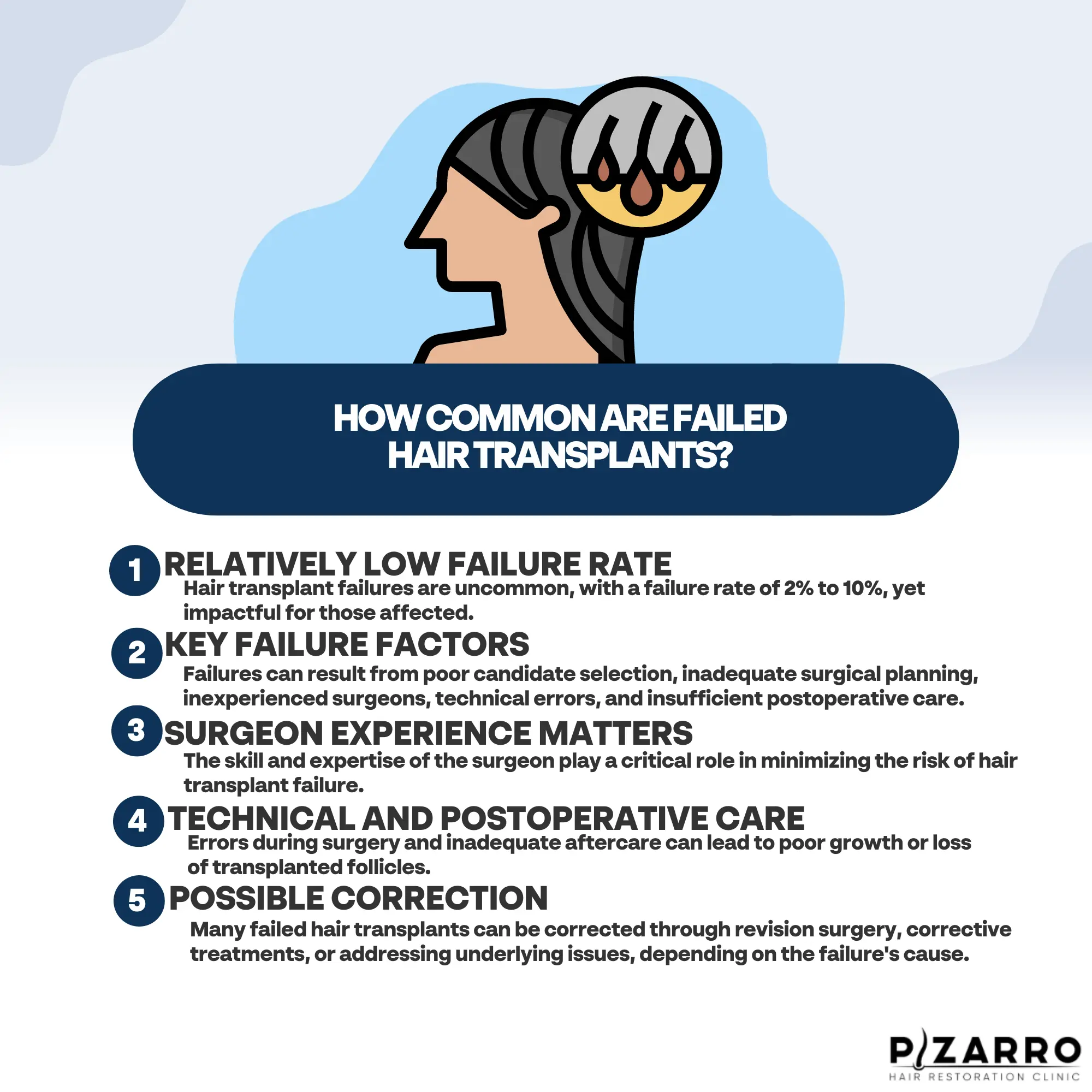Who would not want a full head of hair, right? It’s a dream come true for many people who have struggled with hair loss. Thanks to advancements in science and technology, hair transplants have made this dream a reality for thousands of individuals.
However, as with any medical procedure, there is always a risk of failure. While hair transplant failure is relatively rare, it can be disheartening and emotionally challenging for those who experience it. Understanding the hair transplant failure rate and its reasons is crucial for anyone considering this procedure.
What is a Hair Transplant?
A hair transplant is a surgical procedure. This is done by extracting hair follicles from the “donor area,” and implanting them in another area, known as the “recipient area.” The goal is to restore hair in places that have become thin or bald.
The two primary methods of hair transplantation are: follicular unit transplantation (FUT) and follicular unit extraction (FUE). FUT involves removal of a strip of hair follicles from the donor area and extracting individual hair follicles from that strip. Conversely, FUE involves extracting hair follicles directly from the donor area using a punching tool.
How Common Are Failed Hair Transplants?
Failed hair transplants are relatively uncommon, with a failure rate ranging from 2% to 10%. While this percentage may seem small, it’s essential to remember that behind each statistic is someone who has invested time, money, and hope in achieving a successful hair restoration.
When it comes to what a successful hair transplant is, the answer can be subjective, as it depends on individual expectations. Some people may consider a transplant a failure if the desired density or hairline is not achieved, even if the transplanted hair grows successfully.

Why Do Hair Transplants Fail?
Several factors can contribute to hair transplant failure. Understanding these reasons can help patients make informed decisions and minimize the risk of unsuccessful outcomes. The following are common causes of hair transplant failure:
1. Poor Candidate Selection:
Only some people are ideal candidates for a hair transplant. Patients with insufficient donor hair, unstable hair loss, or underlying medical conditions that may hinder the healing process are at higher risk of transplant failure. Evaluate your current state and have realistic expectations before proceeding with the procedure.
2. Inadequate Surgical Planning:
Successful hair transplantation requires careful planning to ensure the appropriate number of grafts, proper placement, and natural-looking results. When surgical planning is inadequate, it can result in an unnatural hairline, poor coverage, or an unsatisfactory aesthetic outcome.
3. Inexperienced Surgeons:
The skill and experience of the surgeon are critical factors in the success of a hair transplant. Inexperienced surgeons may need more expertise to handle potential complications during the procedure, increasing the risk of failure. Patients should always choose a qualified and experienced hair transplant specialist to minimize this risk.
4. Technical Errors:
Technical errors during the transplant procedure can compromise the viability of the transplanted hair follicles. These errors may include improper graft handling, trauma during extraction or implantation, and suboptimal preservation methods. Such errors can result in poor hair growth or the death of transplanted follicles.
5. Inadequate Postoperative Care:
Proper postoperative care is crucial for the success of a hair transplant. Failure to follow the prescribed care instructions, such as avoiding vigorous activity or not taking the prescribed medication may increase the risk of transplant failure and result in complications. Patients must be diligent in their postoperative care to give their transplanted hair the best chance of survival.
6. Pre-existing Hair Conditions:
Having pre-existing hair conditions, such as alopecia areata or scalp infections, can increase the risk of hair transplant failure. These conditions can compromise the health of the existing hair and the transplanted follicles, leading to poor growth or the loss of transplanted hair.
7. Unrealistic Expectations:
Unrealistic expectations and goals can also contribute to the perceived failure of a hair transplant, even if the procedure is technically successful. Patients anticipating a complete restoration of their youthful hairline or an unrealistic increase in hair density may feel dissatisfied with the results, leading to a subjective assessment of failure.
Can Failed Hair Transplants Be Fixed?
In many cases, failed hair transplants can be fixed, but it depends on the underlying cause of the failure. Patients should consult a skilled hair transplant expert to come up with the best steps to follow. Some possible solutions for failed transplants include:
1. Revision Surgery:
If the initial transplant resulted in significant aesthetic issues, such as an unnatural hairline or poor coverage, a revision surgery may be considered. This procedure aims to correct the previous errors and improve the overall outcome.
2. Corrective Treatments:
Corrective treatments, such as scalp micro pigmentation or hair loss medications, may be recommended to camouflage any visible defects or enhance the appearance of the transplanted hair.
3. Addressing Underlying Issues:
In cases where the transplant failed due to underlying medical conditions or ongoing hair loss, addressing these issues is crucial. Before considering a repeat transplant, this may involve medical treatments to stabilize hair loss or improve scalp health.
The Bottom Line
While failed hair transplants can be disheartening, the overall hair transplant failure rate is relatively low. For better chances of hair restoration success, patients should carefully select an experienced surgeon, have realistic expectations, and follow the prescribed pre and postoperative care.
Get Your Florida Hair Transplant with Pizarro Hair Restorations
If you’re considering a Florida hair transplant, trust the experts at Pizarro Hair Restorations. We’ll walk you through the process, and we can discuss your concerns and needs. Don’t let hair loss hold you back any longer. Call us for a fuller, healthier head of hair.






